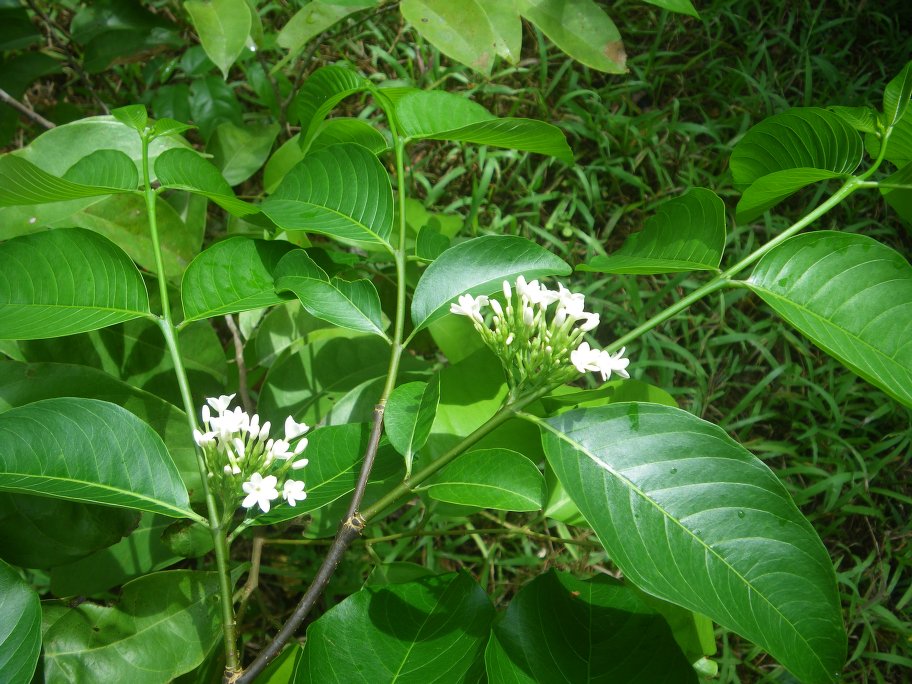Holarrhena floribunda

|
|
Holarrhena floribunda Common Names: Conessi, False Rubber Tree, Holarrhena Scientific
Classification Kingdom: Plantae Clade: Tracheophytes Clade: Angiosperms Clade: Eudicots Clade: Asterids Order: Gentianales Family: Apocynaceae Genus: Holarrhena Species: H. floribunda Authority: (G.Don) T.Durand & Schinz Synonyms: Holarrhena africana A.DC., Holarrhena ovata A.DC., Holarrhena wulfsbergii Stapf, Rondeletia floribunda G.Don Morphological Description Holarrhena floribunda is a small to medium-sized deciduous tree in the Apocynaceae
family, typically growing 5–17 m tall: · Stem: Bark grey to brown, rough, exuding white latex when cut
(Burkill, 1985). · Leaves: Simple, opposite, elliptic to lanceolate, 10–20 cm long, 3–7
cm wide, acuminate apex (Fern, 2024). · Flowers: White, fragrant, 1–2 cm long, in dense terminal corymbs; 5-lobed
corolla (Ahmed et al., 2017). · Fruits: Slender, cylindrical follicles, 20–40 cm long, paired,
containing numerous seeds with silky hairs (Burkill, 1985). Distribution and Habitat Holarrhena floribunda is widespread in tropical West and Central Africa: · Range: Senegal, Gambia, Guinea, Nigeria, Cameroon, Democratic
Republic of the Congo (Botanic Gardens Conservation International & IUCN
SSC Global Tree Specialist Group, 2019). · Habitat: Open forests, forest margins, savannah woodlands,
riverbanks; thrives in well-drained soils, 0–1,200 m altitude (Fern, 2024). Ethnopharmacology Holarrhena floribunda is a cornerstone of West African traditional medicine, it is
extensively utilized in traditional medicine for its diverse therapeutic
properties. The bark is renowned for treating dysentery and diarrhea, often
prepared as a decoction or macerated in palm wine. Both the stem bark and
leaves are employed to manage fevers, particularly malaria, through oral
consumption or therapeutic baths. In Ghanaian folk medicine, the stem bark
addresses inflammation-related conditions such as diabetes and hypertension.
The plant also serves in treating female infertility, venereal diseases, skin
infections, and as an antidote for snake bites. Phytochemical analyses have
identified various bioactive compounds, including alkaloids, which contribute
to its medicinal efficacy: · Antimalarial: Bark decoctions used in used as antimalarial. · Antidiarrheal: Bark infusions in Nigeria for dysentery; methanol extract
(110.22 mg/kg) reduced fecal output in rats by 69% (Udoh et al., 2020). · Anti-inflammatory: Leaf extracts in Ghana for pain; ethanol
extract (200 mg/kg) reduced edema in rats by 32% (Bogne et al., 2012). · Anthelmintic: Seeds in Mali against worms; seed extract showed activity
against Haemonchus contortus in vitro (Burkill, 1985). ⚠ Toxicity Profile: Mild toxicity noted; high doses of bark extract (>2,000 mg/kg)
caused lethargy and liver enzyme elevation in mice (Bogne et al., 2012). Additional Uses · Construction: Hard, heavy wood used for tool handles, carvings (Fern,
2024). · Cultural: Bark used in Nigeria as a tonic and febrifuge (Burkill,
1985). · Ecological: Planted for shade and erosion control in agroforestry (Ahmed
et al., 2017). References
External Links More Pictures |
|
| Compounds of Holarrhena floribunda | |
| References |